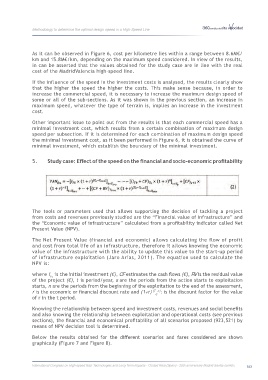Page 545 - 360.revista de Alta Velocidad - Nº 6
P. 545
Methodology to determine the optimal design speed in a High-Speed Line
As it can be observed in Figure 6, cost per kilometre lies within a range between 8.6M€/
km and 15.8M€/km, depending on the maximum speed considered. In view of the results,
in can be asserted that the values obtained for the study case are in line with the real
cost of the MadridValencia high-speed line.
If the influence of the speed in the investment costs is analysed, the results clearly show
that the higher the speed the higher the costs. This make sense because, in order to
increase the commercial speed, it is necessary to increase the maximum design speed of
some or all of the sub-sections. As it was shown in the previous section, an increase in
maximum speed, whatever the type of terrain is, implies an increase in the investment
cost.
Other important issue to point out from the results is that each commercial speed has a
minimal investment cost, which results from a certain combination of maximum design
speed per subsection. If it is determined for each combination of maximum design speed
the minimal investment cost, as it been performed in Figure 6, it is obtained the curve of
minimal investment, which establish the boundary of the minimal investment.
5. Study case: Effect of the speed on the financial and socio-economic profitability
The tools or parameters used that allows supporting the decision of tackling a project
from costs and revenues previously studied are the “Financial value of infrastructure” and
the “Economic value of infrastructure” calculated from a profitability indicator called Net
Present Value (NPV).
The Net Present Value (financial and economic) allows calculating the flow of profit
and cost from total life of an infrastructure, therefore it allows knowing the economic
value of the infrastructure with the ability to update this value to the start-up period
of infrastructure exploitation (Jaro Arias, 2011). The equation used to calculate the
NPV is:
where I is the initial investment (€), CF estimates the cash flows (€), RV is the residual value
To
of the project (€), t is period/year, s are the periods from the action starts to exploitation
starts, n are the periods from the beginning of the exploitation to the end of the assessment,
r is the economic or financial discount rate and (1+r) (T -t) : is the discount factor for the value
0
of r in the t period.
Knowing the relationship between speed and investment costs, revenues and social benefits
and also knowing the relationship between exploitation and operational costs (see previous
sections), the financial and economical profitability of all scenarios proposed (923,521) by
means of NPV decision tool is determined.
Below the results obtained for the different scenarios and fares considered are shown
graphically (Figure 7 and Figure 8).
International Congress on High-speed Rail: Technologies and Long Term Impacts - Ciudad Real (Spain) - 25th anniversary Madrid-Sevilla corridor 543

